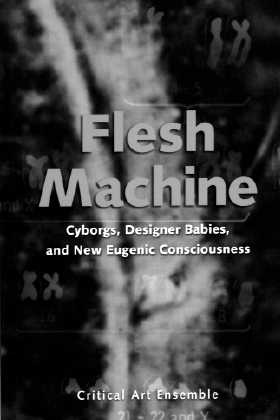Cloning the Drones
J.J. King reviews Flesh Machine: Cyborgs, Designer Babies, and New Eugenic Consciousness, Critical Art Ensemble (Autonomedia $8) CAE (over)identify (with) a triad of machines at the dead centre of pancapitalism - sight, war, flesh - around whose operations State constitutes itself. The sight machine manages the home front, promulgating the necessary ideologues on TV, radio and the Net, whilst mapping out frontier territories in order to identify and prepossess the next commodity; it co-opts the social whilst cooperating with the war machine, which it provides with the data required to maintain capitalism's continued existence via the petrifying, pan-global gaze of lethal martial force. The flesh machine extends this stare into the body itself. Our cyborgian worker (mobile phone, laptop, velcro pocket full of acetylcholine: ready for operation 24/7) is just a stand in, and a sign of what's to come: the flesh machine will market eugenics as a consumer choice to parents by interfacing with the substantial work ethic ('Of course, we must give Johnny the best chance in life') propped up by the sight machine - tweaking genes to make humans who sleep less, work harder and don't freak out when the heat's turned up.
CAE (over)identify (with) a triad of machines at the dead centre of pancapitalism - sight, war, flesh - around whose operations State constitutes itself. The sight machine manages the home front, promulgating the necessary ideologues on TV, radio and the Net, whilst mapping out frontier territories in order to identify and prepossess the next commodity; it co-opts the social whilst cooperating with the war machine, which it provides with the data required to maintain capitalism's continued existence via the petrifying, pan-global gaze of lethal martial force. The flesh machine extends this stare into the body itself. Our cyborgian worker (mobile phone, laptop, velcro pocket full of acetylcholine: ready for operation 24/7) is just a stand in, and a sign of what's to come: the flesh machine will market eugenics as a consumer choice to parents by interfacing with the substantial work ethic ('Of course, we must give Johnny the best chance in life') propped up by the sight machine - tweaking genes to make humans who sleep less, work harder and don't freak out when the heat's turned up.
CAE are, undoubtedly, aware of the limiting polemicism of their text. Words like 'terrifying', 'frightening' and 'disturbing' litter Flesh Machine, demanding a response which goes beyond the theoretic. In their use of pointedly brief, simple sentences which never sacrifice comprehensibility, and of frequent examples, the Ensemble reveal themselves as propagandists committed to making marks on praxis. And, as is often the way with propaganda, the broad brush strokes lead to serious omissions and inconsistencies: the depiction here of pancapital deploying its machinic assemblages with an awful precision is wilfully misleading. Plainly, the machines identified by the Ensemble are in permanent conflict. Don't the tobacco industry (after all, a crucial component of pancapitalism, and a totem for the manufacture of desire - let's call it the fag machine) and the flesh machine operate each to undercut the other's operation, with the fag machine paying for the production of falsified reports about the relationship of smoking to cancer, thus undermining the flesh machine's attempts to produce the anti-smoking propaganda which is hoped to significantly advance, in the long term, its project of augmenting the labour pool through the production of hyperfunctional human beings?
One can't help concluding that CAE's work concertedly excludes such counterexamples in the struggle to produce a good polemic. In considering the pharmacopoeial face of the flesh machine, their selection of drugs is disturbingly occlusive, foregrounding the medical use of painkillers, tranquillisers, antidepressants and smart drugs to show how medicine sets out to whip the ass of the flesh into shape. The absentee drugs, of course, specify - again - a chemical counteroperativity: while on the one hand the normative, palliative, biochemical interventions of pharmacology operate to return mentally and physically sick people back to their proper place in the capitalist machine, dissociative (Ketamine, PCP), psychedelic (e.g., LSD, Psilocybin, DMT) and ecstatic (e.g., MDMA, MDA, MDEA) chemicals propel users towards a transgression of the normal, of the boundaries of the real (notice I'm not mentioning cocaine or amphetamine here, the only recreational drugs CAE seem to pay attention to). How could the orchestrated process proposed by the Ensemble admit any such counter-activity into the game? And doesn't the possibility of showing the contra-machine to every state machine, and the always imperfect operation of these state machines, indicate that the whole process may be far more partial than CAE make out?
In short, CAE's is the usual agitprop tactic (as deployed by the likes of Noam Chomsky) of stirring up the proles with oversimplified analyses which galvanise action through their stark depiction of a repressive state machinery. This time-honoured practice probably doesn't deserve too harsh a criticism from lesser radicals. But still: isn't it possible that the Ensemble, through this horrifying portrayal of a monolithic-machinic triad at centre of the postmodern state, cleanly stem the flow of dissent they seek to manufacture? Might not a more partial analysis, a less intimidating Weltanschaung, conversely promote resistance precisely by downscaling the target's immanence? Perhaps, in the face of the diversity of power structures in the postmodern state, the best zamisdats are those which commend us to dispersed and partial action, not those which, like Flesh Machine, offer a massively intimidating analysis only to demand that, by way of a reply, "the unspeakable be spoken, and the impossible be done."
JJ KingXjamie AT metamute.comX
Mute Books Orders
For Mute Books distribution contact Anagram Books
contact@anagrambooks.com
For online purchases visit anagrambooks.com







